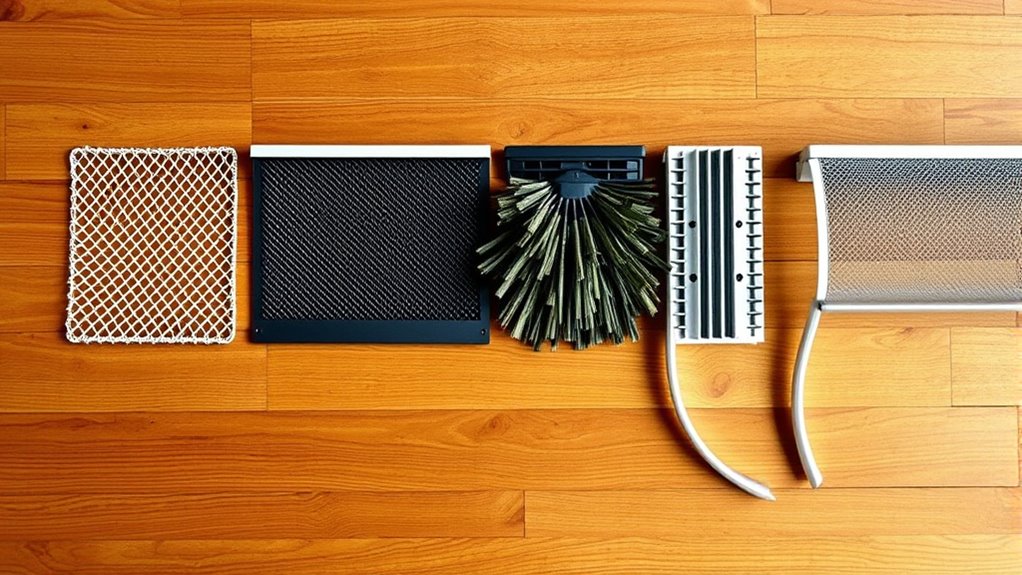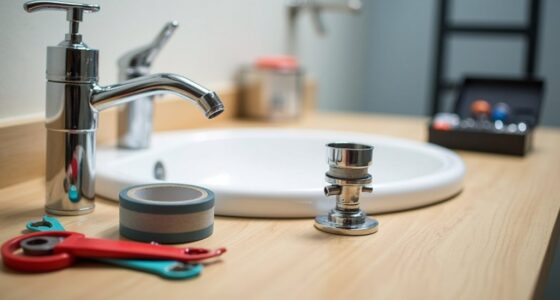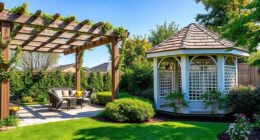When choosing between gutter guard types, consider mesh, screen, brush, and reverse curve options. Mesh guards trap small debris, while screens block larger items but need more maintenance. Brush guards are easy to install but can get clogged, and reverse curve guards are efficient in heavy rain but may require professional installation. Each has unique upkeep needs, so knowing these differences will help you decide which is best for your gutters. There’s plenty more to explore about these options!
Key Takeaways
- Mesh Gutter Guards: Durable and effective against small debris, requiring regular maintenance and filter replacement every 6-12 months; suitable for DIY installation.
- Screen Gutter Guards: Affordable and easy to install, designed to block larger debris but need annual cleaning to prevent clogging from smaller particles.
- Brush Gutter Guards: Feature bristles that trap large debris while allowing water flow; easy to install but require regular maintenance to clear tangled particles.
- Reverse Curve Gutter Guards: Utilize surface tension for effective water channeling; require careful installation and may necessitate professional help due to complexity.
- Maintenance Needs: All types require regular inspections and cleaning, with specific schedules varying based on the guard type to ensure optimal performance.
What Is a Gutter Guard?
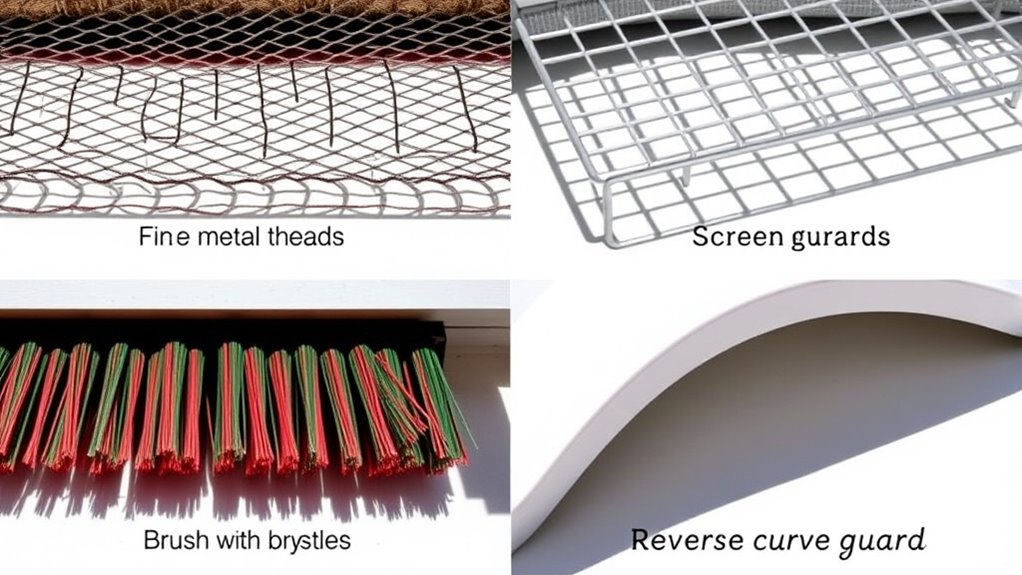
A gutter guard is your first line of defense against clogged gutters. These protective coverings fit over or inside your gutters, preventing debris like leaves and twigs from causing blockages. By facilitating the smooth flow of water, gutter guards reduce the need for frequent maintenance and help avoid costly repairs. You’ll find various types of gutter guards available, including mesh, screen, brush, and reverse curve options, each offering unique benefits and maintenance requirements. Some are even DIY-friendly, while others may need professional installation to guarantee they function correctly and comply with warranty standards. Regular maintenance can extend appliance lifespan by helping to ensure that your gutter guards remain effective over time. Additionally, selecting the right gutter guards can significantly improve indoor air quality by preventing mold and mildew growth caused by water overflow. Using gutter guards can also lower the overall energy consumption of your home by reducing the potential for water damage that may lead to inefficient insulation or heating systems. The installation of gutter guards is a cost-effective renovation that helps protect your home’s infrastructure. With gutter guards, you not only protect your gutters from debris but also prolong their lifespan by shielding them from UV rays and pests. The cost of home security systems often justifies the investment in preventive measures like gutter guards to avoid expensive repairs.
Mesh Gutter Guards

When it comes to mesh gutter guards, you’ll appreciate their sturdy materials like stainless steel or aluminum that resist rust and last for years. Installing them is usually a breeze, making it a great DIY project for homeowners. Plus, you’ll want to keep up with maintenance to guarantee they function effectively, so let’s explore what that involves. Regular maintenance includes filter replacement every 6-12 months to ensure continued efficiency, and this is crucial for maintaining optimal performance of the system. Additionally, ensuring that your skin remains adequately hydrated can help maintain skin health during outdoor projects, as exposure to the elements can affect your skin’s condition. It’s also important to consider long-term financial planning to cover possible future maintenance costs associated with home improvements like gutter guards. Furthermore, regular inspections can help identify any needed repairs or effective solutions to enhance the longevity of your gutter system.
Material Durability Comparison
While considering gutter protection, it’s essential to compare the durability of different materials used in mesh gutter guards. Typically made from stainless steel or aluminum, mesh gutter guards offer superior longevity and resistance to corrosion compared to plastic options. Additionally, investing in a diversification strategy for your gutter protection can ensure that you have multiple layers of defense against debris accumulation. This approach allows for enhanced creativity in designing your gutter system to better handle various weather conditions. Moreover, using materials that are resistant to pollution and corrosion can further enhance the longevity of your gutter guards.
Their fine construction captures even the smallest debris, enhancing material durability and preventing clogs effectively. In contrast, screen gutter guards are less durable and may require frequent replacement due to UV exposure and weather conditions. Brush guards can lead to debris accumulation, needing more maintenance. When you invest in high-quality materials like stainless steel or aluminum, you guarantee that your gutter protection lasts longer than alternatives such as reverse-curve gutter guards, providing peace of mind and efficient water flow. Additionally, selecting high-quality materials can significantly impact the overall effectiveness of your gutter system. Raw food diets often require careful planning to meet caloric needs, ensuring that your gutter system has the proper support for optimal performance.
Installation Process Overview
Choosing the right gutter guard is just the beginning; understanding how to install mesh gutter guards effectively is just as important. The installation process is straightforward, making it a great option for DIY gutter guards.
Here are key steps to take into account:
- Clean gutters thoroughly before installation to guarantee proper adherence and effective water drainage. Regular maintenance tasks are essential to keep your gutters functioning properly after installation. Additionally, regular cleaning of the gutters will prevent the buildup of debris and clogs, ensuring optimal performance. It is also beneficial to remember that spiritual principles can guide you in maintaining a consistent routine for home care. Furthermore, air quality considerations can impact the overall health of your home environment, making proper gutter function even more critical.
- Secure the mesh under roof shingles or snap it onto the gutters, allowing ideal water flow while blocking debris.
- Think about professional installation for complex roof designs or if customization is needed.
After installation, regular inspections are essential to keep your mesh guards clear and functioning at their best. Additionally, consider the importance of advance directives in your overall planning, as they can provide clarity on decision-making in unexpected situations.
Maintenance Requirements Explained
To keep your mesh gutter guards functioning effectively, regular maintenance is essential. You’ll need to clean them once or twice a year to remove accumulated debris, ensuring ideal water flow and preventing clogs. Here’s a quick overview of the maintenance requirements:
| Maintenance Task | Frequency |
|---|---|
| Cleaning | Once or twice a year |
| Periodic Inspections | Twice a year |
| Check for Clogs | After heavy storms |
| Inspect Installation | After installation |
Use a hose sprayer and scrub brush for cleaning, as fine particles can get trapped in the mesh. Remember, these responsibilities fall on you as a homeowner to keep your system working efficiently and to avoid any issues with your gutters. Additionally, just as regular cleaning of electric vehicles is necessary to maintain performance, it’s crucial for your gutter guards to remain effective. Regular maintenance not only prevents clogs but also ensures that your gutter system remains a reliable hedge against heavy rainfall and protects your home from water damage. Maintaining your gutter guards is part of a broader commitment to responsible cookie usage and ensuring your home remains safe and dry. Furthermore, incorporating mindfulness practices during maintenance can enhance your awareness of the task and foster a sense of accomplishment.
Screen Gutter Guards
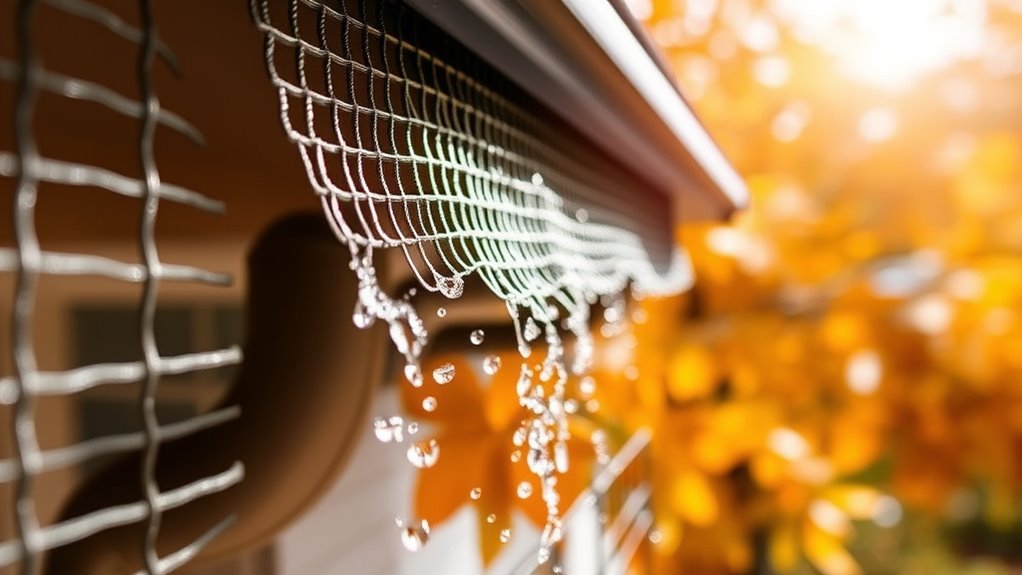
Screen gutter guards are an effective solution for keeping your gutters clear of larger debris like leaves and twigs, allowing water to flow freely.
Made from metal or plastic grids, they’re typically affordable and easy to install, requiring no tools for setup.
Here are a few key points to take into account:
- Installation: Slide the screens under roof shingles, but check with the shingle manufacturer to avoid warranty issues.
- Maintenance: Regularly remove screens for cleaning to prevent clogging and maintain peak performance.
- Annual Cleaning: While they block larger debris, smaller particles can still pass through, so be prepared for an annual cleaning.
With proper installation and maintenance, screen gutter guards can greatly enhance your gutter system’s efficiency.
Brush Gutter Guards
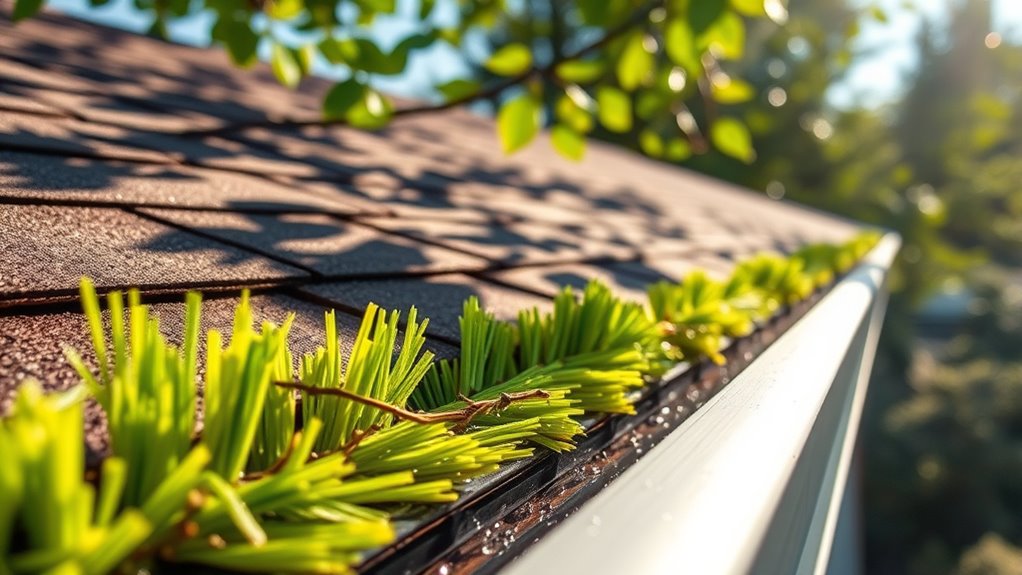
If you’re looking for another effective option to keep your gutters clear, brush gutter guards might be the answer.
These guards consist of large bristles that block large debris like leaves and twigs while allowing water to flow freely. They’re an affordable option, typically costing between $3 to $6 per linear foot, making them popular among DIYers.
You can easily install them without special tools or skills. However, maintenance is necessary since smaller particles can get tangled in the bristles, requiring regular cleaning to prevent clogs.
With their flexible core, brush gutter guards adapt to various gutter shapes, helping you reduce gutter maintenance and keep your system functioning smoothly.
Reverse Curve Gutter Guards

Reverse curve gutter guards offer a unique design that uses surface tension to channel rainwater into your gutters while letting debris fall away.
However, their installation requires careful attention to the angle, and improper setup could lead to issues.
While they can be pricier than other options, their efficiency in heavy rainfall areas makes them a worthwhile consideration.
Design and Functionality
Gutter guards play an essential role in maintaining the efficiency of your home’s drainage system, and reverse curve gutter guards are among the most effective options available. Their unique design allows water to flow over the top while directing debris to fall off, greatly reducing clogs.
Here’s what makes them stand out:
- High flow capacity: Constructed from lightweight materials like aluminum, they handle heavy rainfall effectively.
- Debris management: The curved shape prevents leaves and twigs from entering your gutters.
- Professional installation: Correct installation angle is vital for ideal functionality, which may require lifting roof shingles.
While reverse curve gutter guards can alter your home’s appearance and may affect roof warranties, their functionality in preventing clogs is well worth considering.
Installation Requirements
Understanding the unique design and functionality of reverse curve gutter guards is just the beginning; proper installation is key to their effectiveness.
To achieve the correct angle for water flow, you might need professional assistance, especially since installation involves lifting roof shingles, which can risk your roof warranty if mishandled.
These lightweight metal or molded plastic guards are built to withstand various weather conditions, guaranteeing durability once installed correctly.
Homeowner considerations include the upfront cost, as reverse curve options typically come at a higher price compared to mesh screens.
After installation, regular inspections are essential to verify the guards are functioning effectively and are free from debris clogs, maintaining their performance over time.
Cost Considerations
When considering the expense of reverse curve gutter guards, you’ll find that they typically range from $3.50 to $7 per linear foot, making them one of the pricier options on the market.
While the high initial costs might deter some, there are significant cost considerations to keep in mind:
- Installation often requires professional help, which can increase overall project costs.
- A proper installation angle is vital for effectiveness, potentially leading to extra adjustments.
- These guards can reduce long-term maintenance expenses by minimizing clogs and overflow issues.
Ultimately, weighing these factors against the appearance of your home can help you decide if reverse curve gutter guards are worth the investment.
How to Choose the Right Gutter Guard
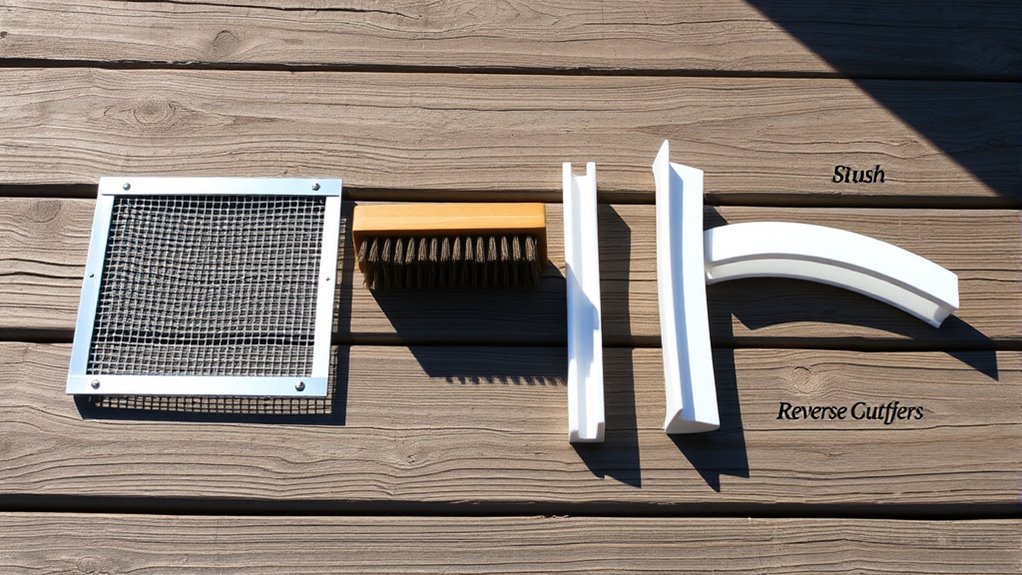
How do you decide which gutter guard is right for your home? Start by evaluating the types of debris common in your area. If you deal with fine particles like pollen, consider mesh guards; for larger debris, brush guards are effective.
Next, think about the installation method. While mesh and screen guards might require professionals, foam inserts are DIY-friendly.
Evaluate maintenance needs too—mesh guards need cleaning once or twice a year, while brush guards may need more frequent attention.
Don’t forget your local climate; reverse-curve guards excel in heavy rainfall as they allow water flow while preventing clogging.
Finally, factor in your budget to make the best choice among the types of gutter guards available.
Frequently Asked Questions
What Is the Most Effective Type of Gutter Guard?
When choosing the most effective type of gutter guard, consider your specific needs.
If you live near trees, you might want something that blocks both large and small debris. If you’re on a budget, simpler options may suffice but will require regular cleaning.
Think about your local climate too—heavy rainfall can influence your choice.
Ultimately, the best guard for you balances effectiveness, maintenance, and cost based on your unique situation.
What Are the Cons of Reverse Curve Gutter Guards?
You might think reverse curve gutter guards are a foolproof solution, but there are significant downsides.
They can be pricey to install, often requiring professionals. If the angle’s off, they won’t direct water properly, risking overflow and damage.
Plus, their visible design might clash with your home’s aesthetics.
Maintenance isn’t a walk in the park either; debris tends to pile up, necessitating regular cleanings to keep them functioning effectively.
What Are the Cons of Mesh Gutter Guards?
When it comes to mesh gutter guards, you might face a few drawbacks.
They often require annual cleaning to prevent fine debris buildup, and their costs can range from $2 to $7 per linear foot, which might strain your budget.
If installed incorrectly or clogged, heavy rain can lead to overflow issues.
Additionally, some designs can discolor from UV exposure, potentially affecting your home’s appearance.
Professional installation may also be necessary for peak performance.
What Is the Difference Between Gutter Guards and Gutter Screens?
Gutter guards and gutter screens both protect your gutters, but they work differently.
Gutter guards cover your gutters to prevent debris from getting in, while gutter screens are made of perforated materials that allow water to flow through while blocking larger debris.
If you’re looking for a solution to keep your gutters clean, you’ll want to contemplate your local environment and the types of debris you typically deal with.
Conclusion
To sum up, choosing the right gutter guard can save you a lot of hassle and maintenance down the road. Did you know that homes without gutter guards can require cleaning as often as every six months, while those with guards can go up to a year or more before needing attention? By investing in the right type, you can not only protect your home but also enjoy more free time. So, pick wisely and enjoy peace of mind!
